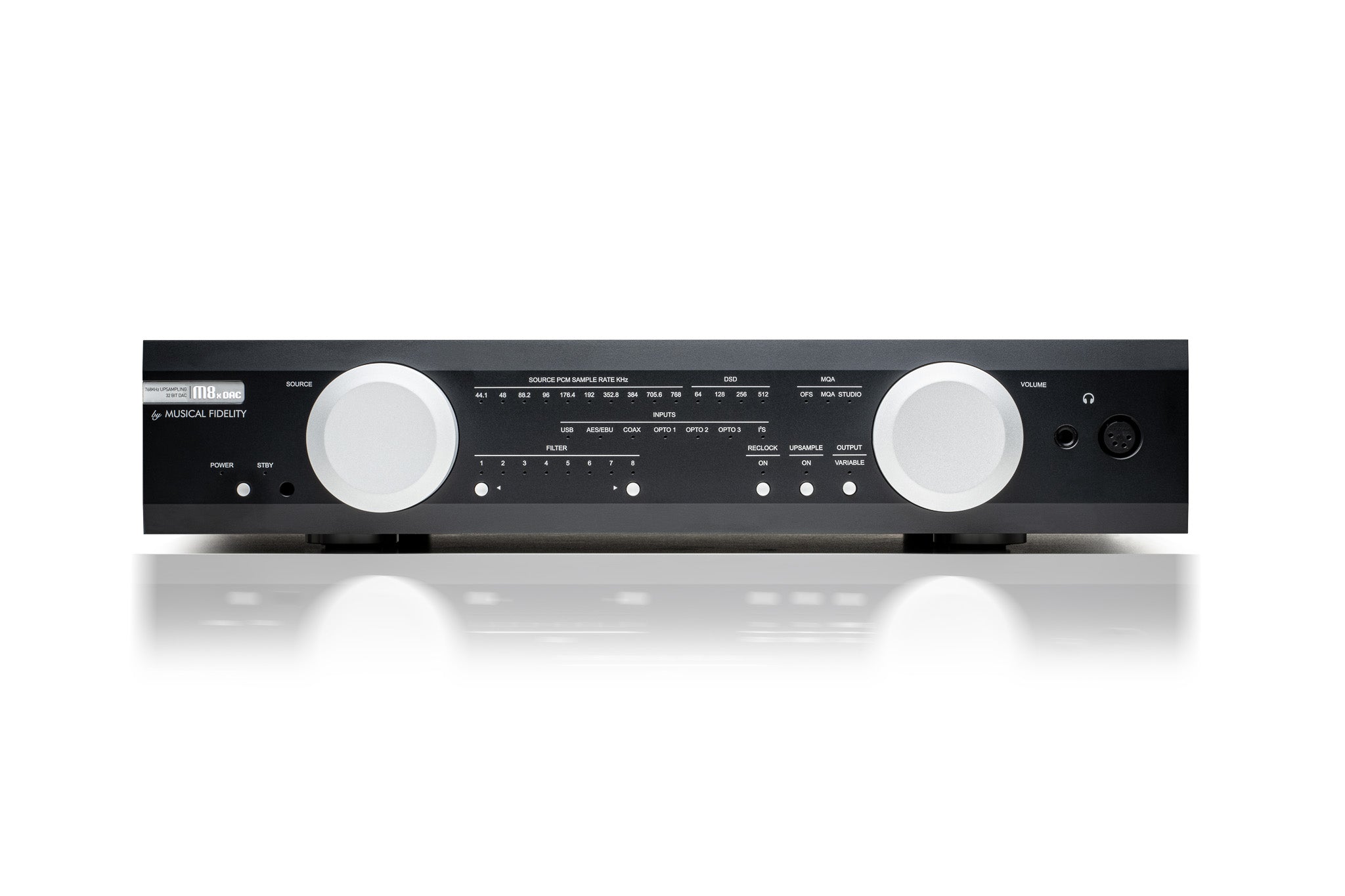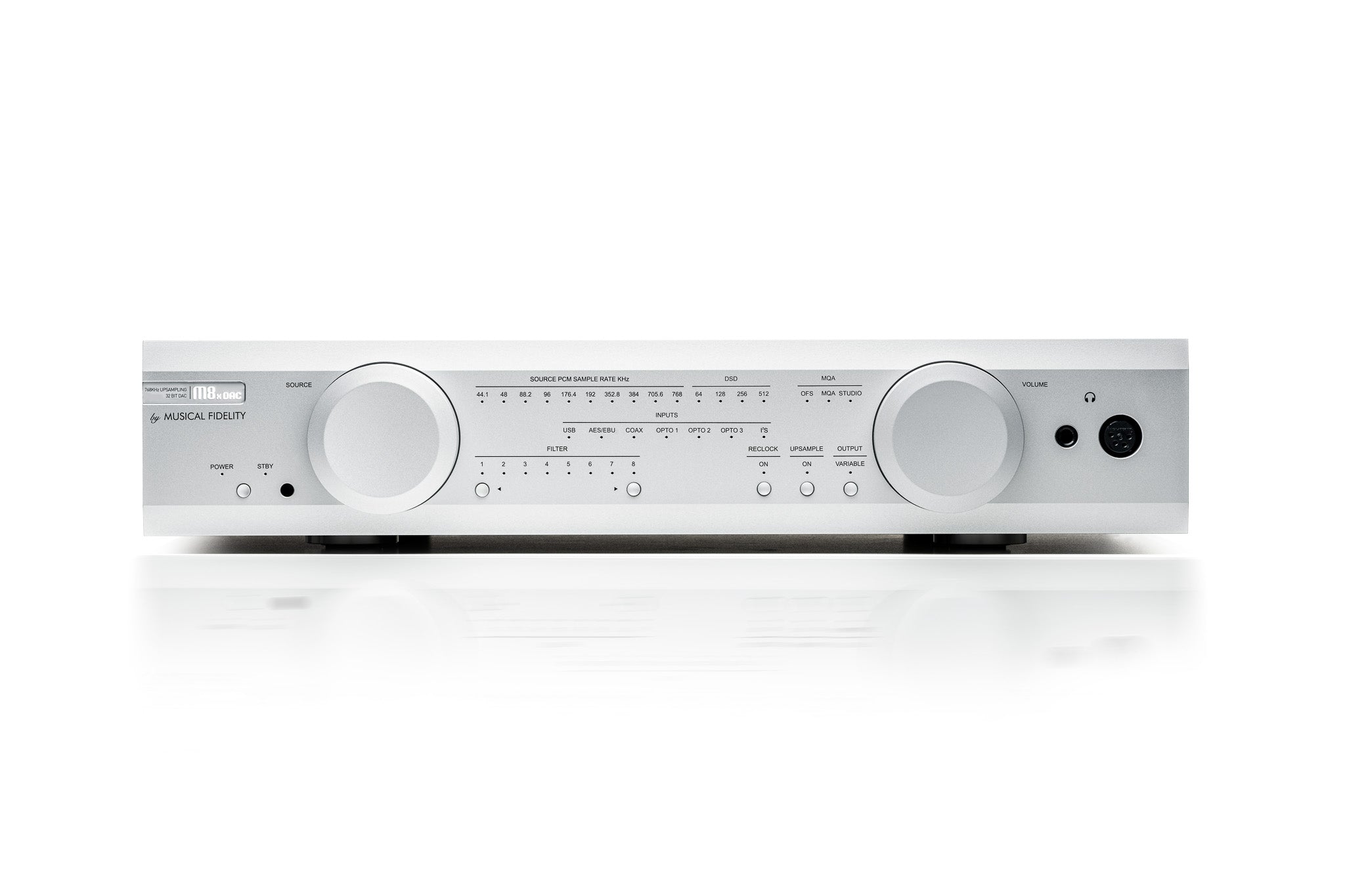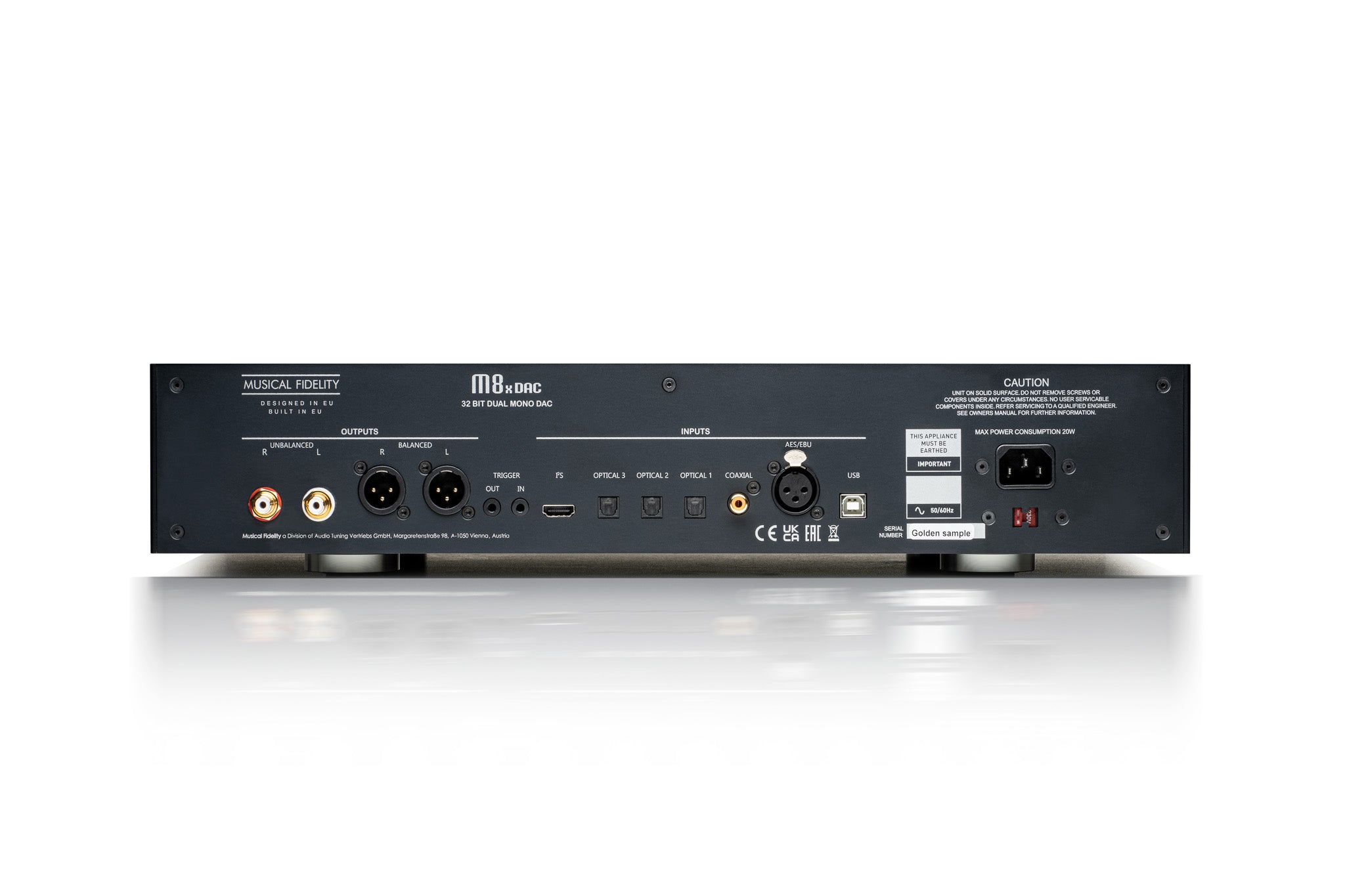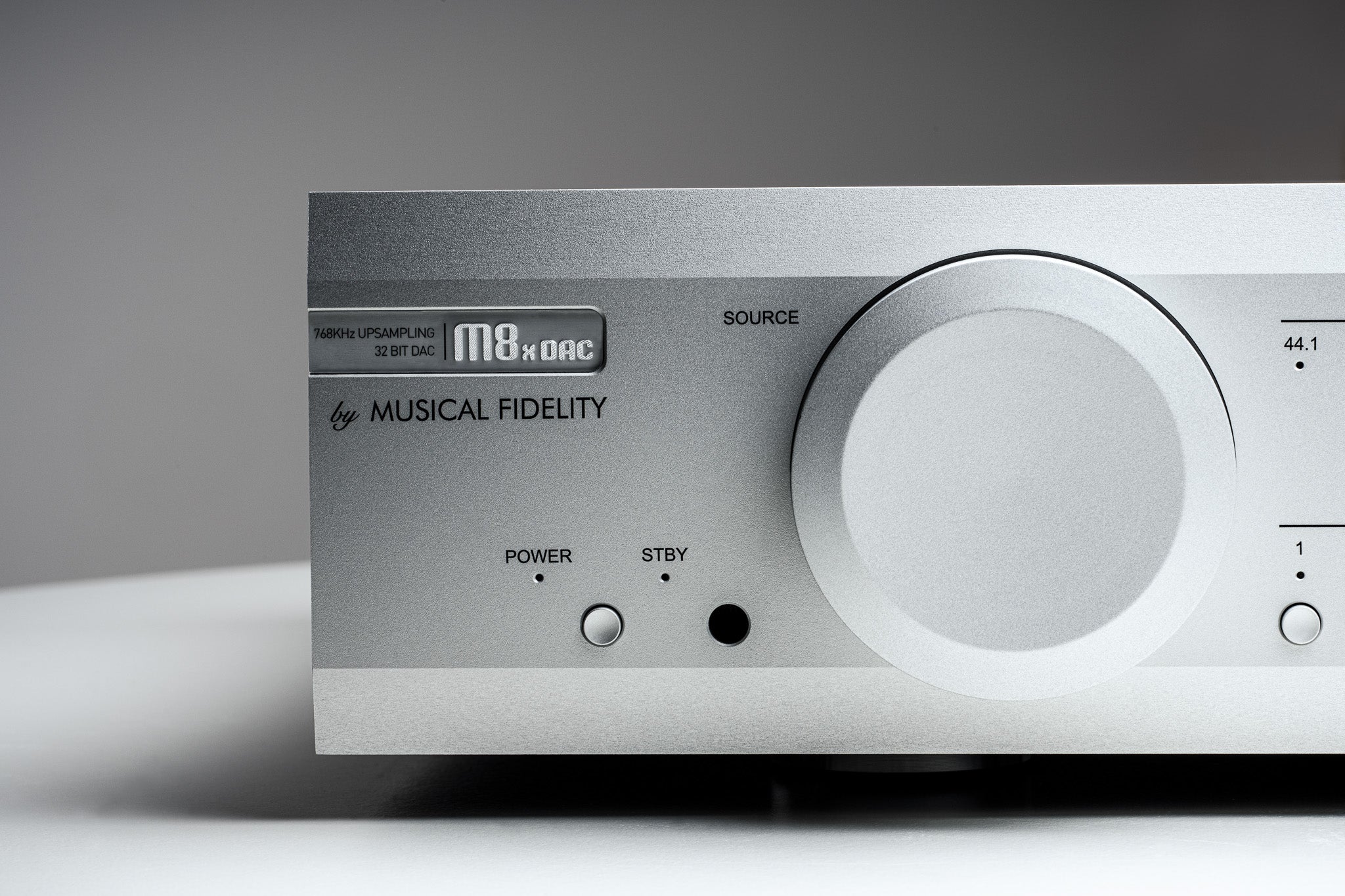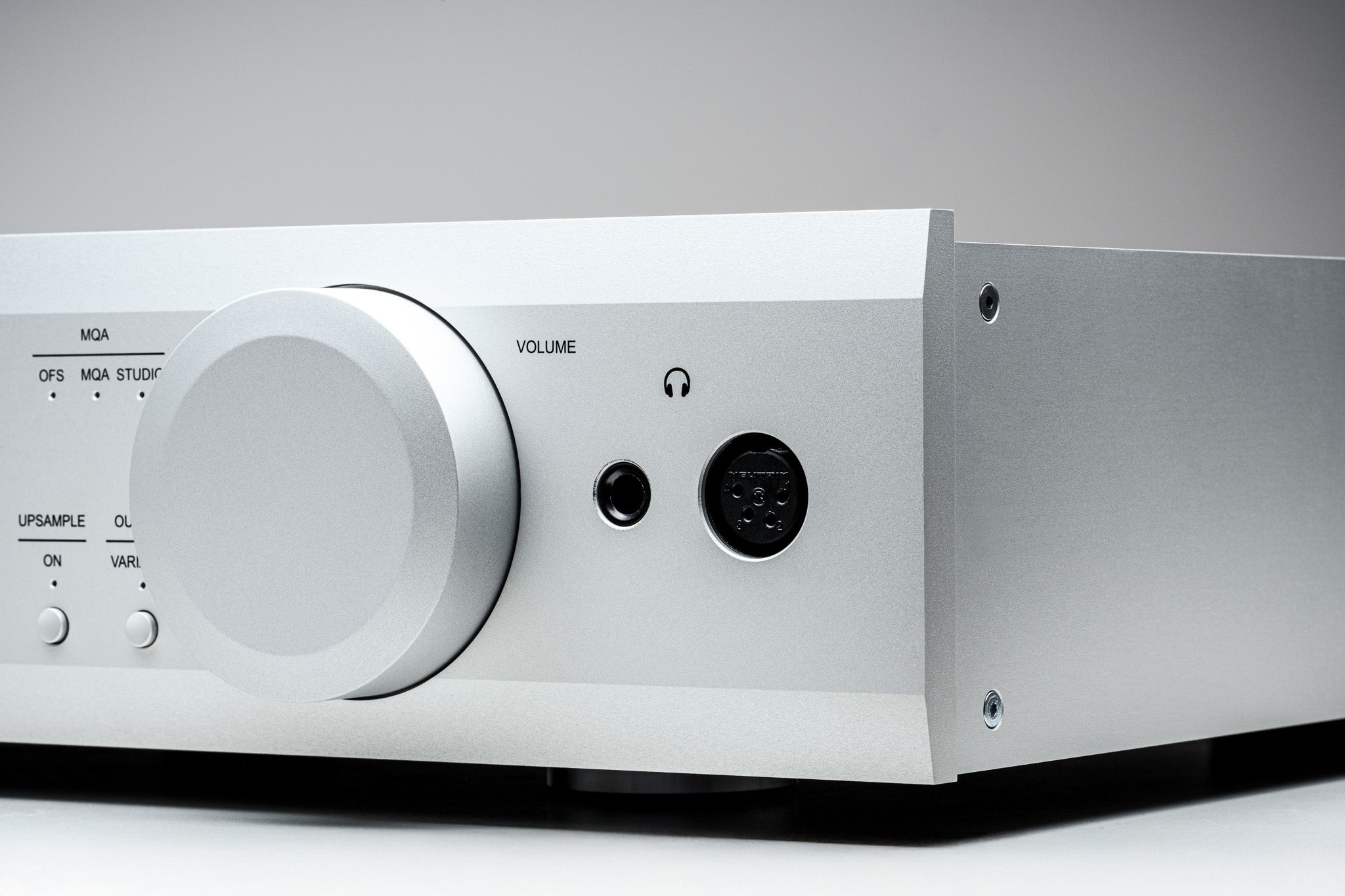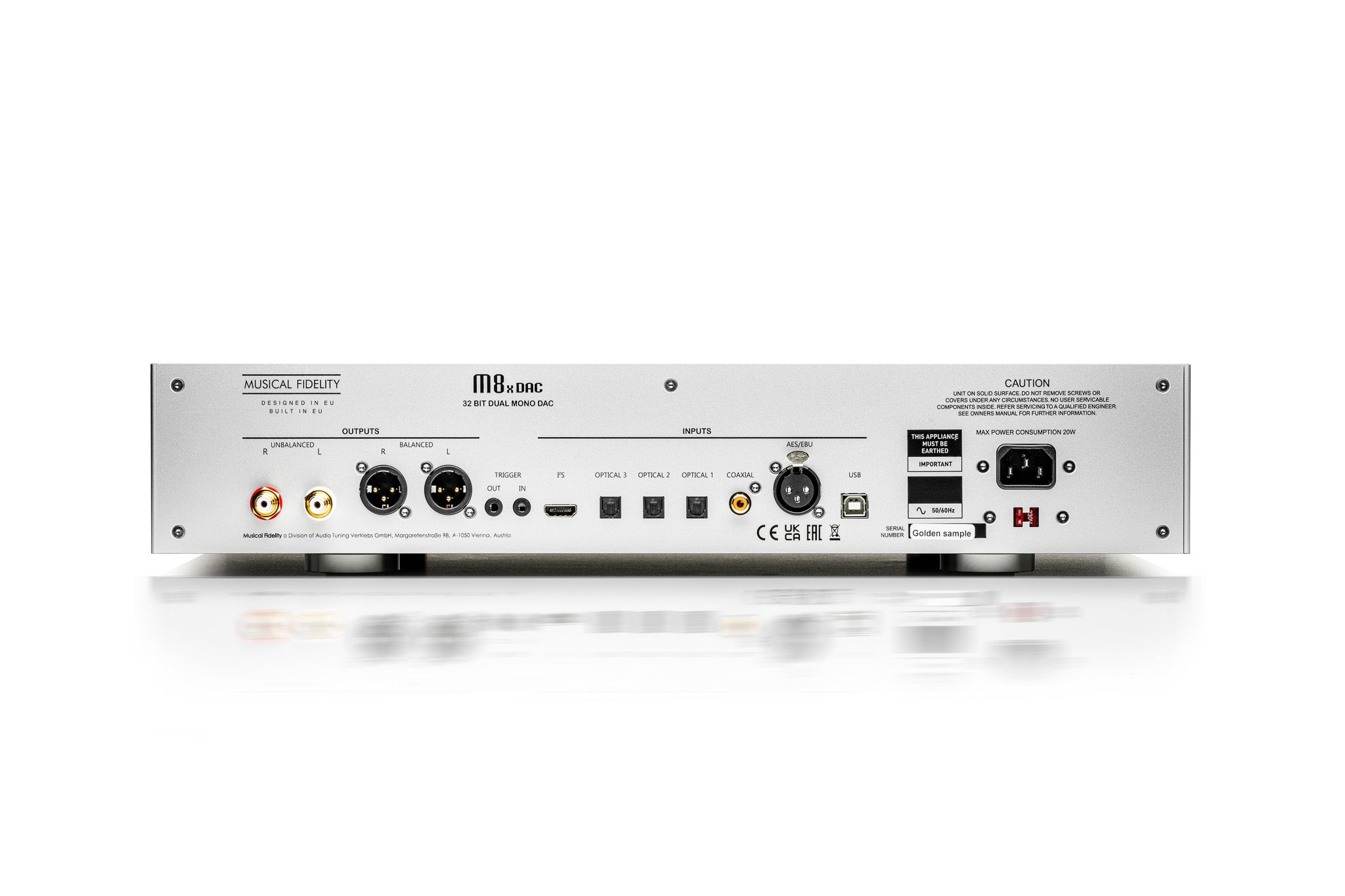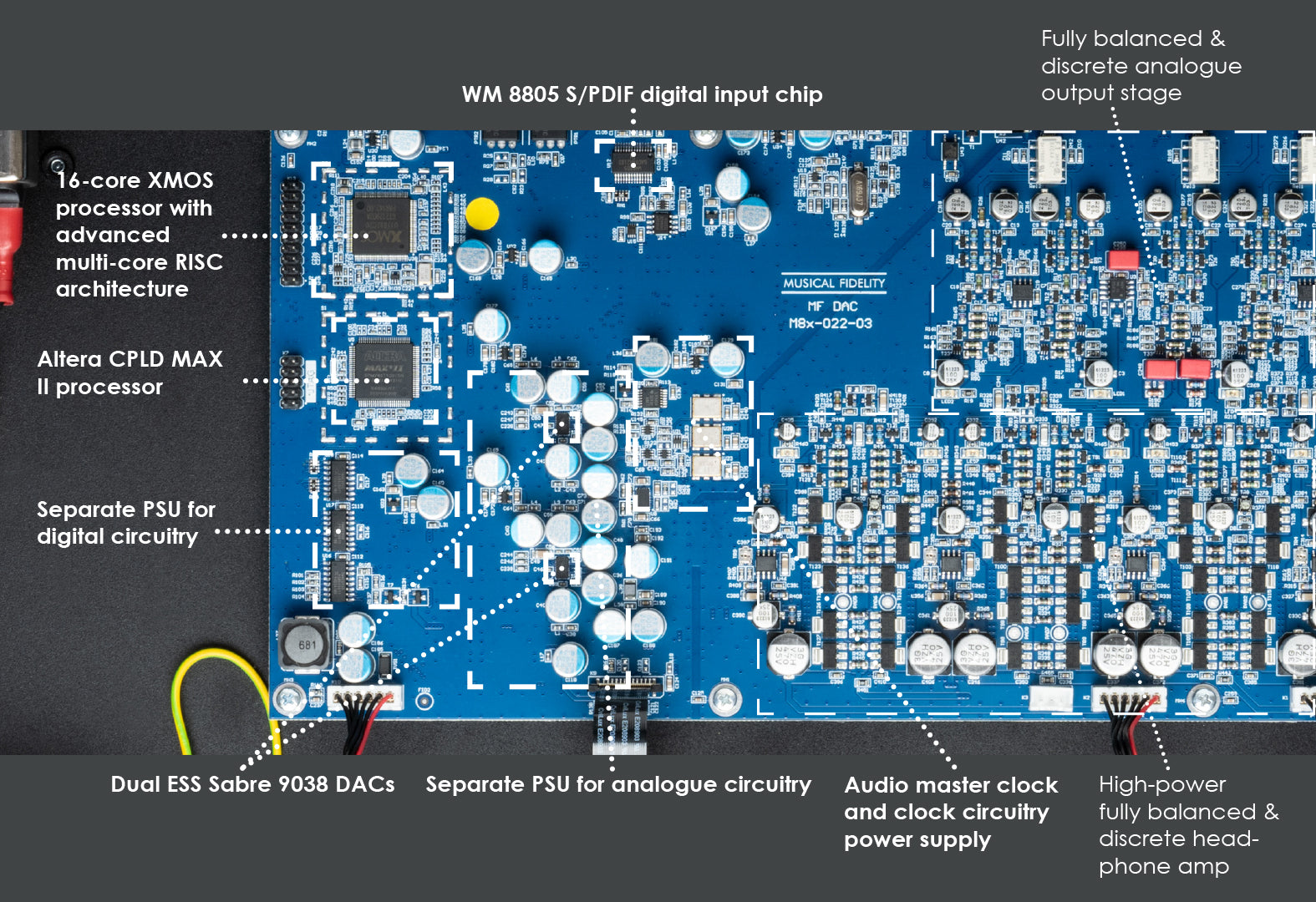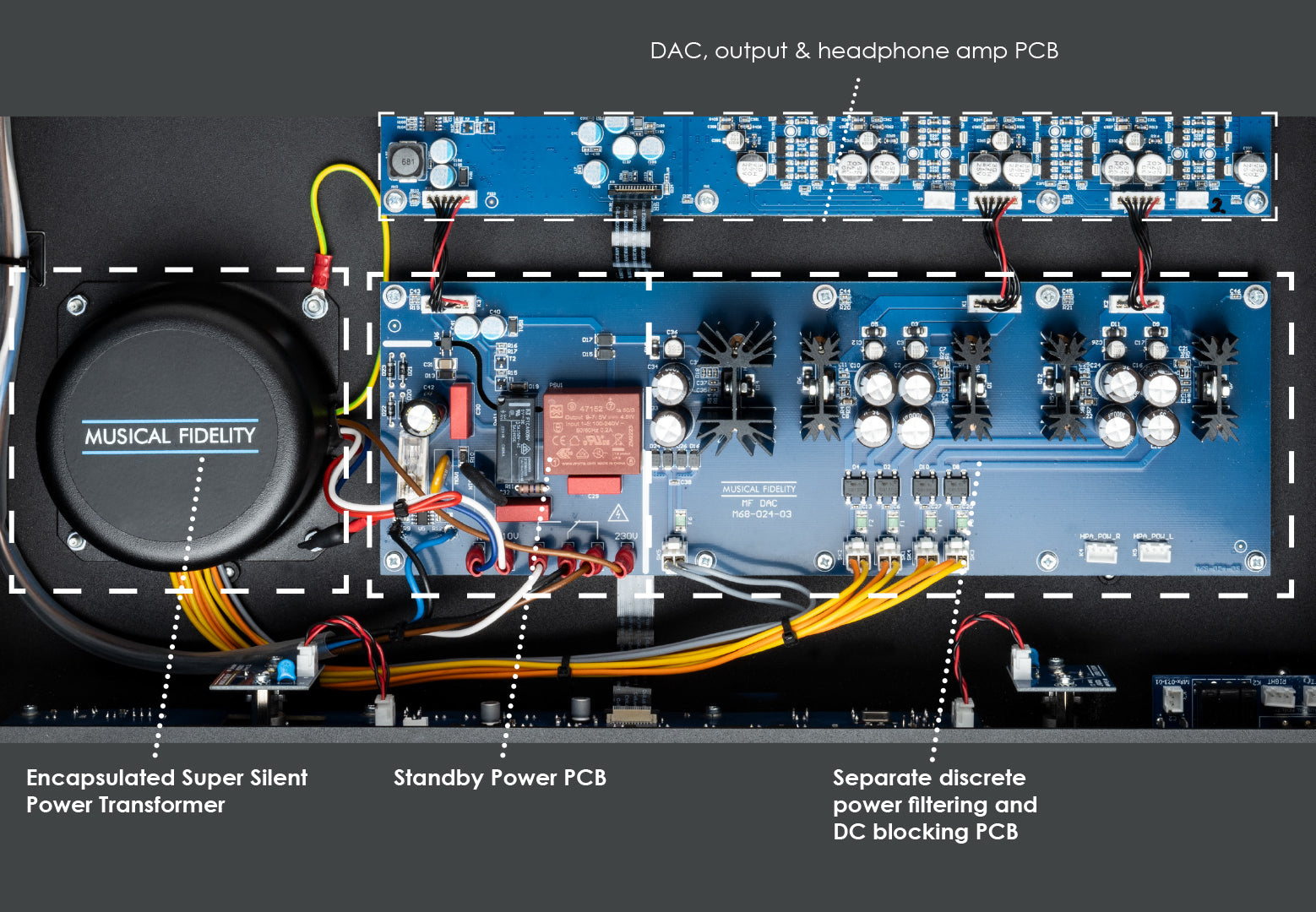Description
Musical Fidelity M8x DAC DA converter
The M8x DAC is a high-end DAC with upsampling, balanced discrete output stages, and a headphone amplifier.
M8x DAC – Overview
The M8x DAC proudly continues Musical Fidelity's tradition of pioneering world-class DAC technology. Back in the early 90s, Musical Fidelity revolutionized audio by developing discrete DAC units to improve the sound quality of CD players.
Today, with digital sources like PC audio and streaming services dominating the market – often built by software companies without hardware expertise – Musical Fidelity leads the way in converting digital signals into stunning analogue audio. The M8x DAC is based on the same design principles as our acclaimed amplifiers, delivering exceptional sound quality:
-
Class A discrete analog amplification ensures clean, detailed sound
-
No display , which reduces unwanted electromagnetic interference
-
No WiFi or Bluetooth , so no RF radiation is generated and performance remains jitter-free
-
Toroidal transformers ensure a stable and clean power supply
-
Robust mechanical construction ensures durability and premium finish
M8x DAC – In a Nutshell
-
DAC circuit: 32-bit Hyperstream II
-
DAC chip: 2x ES9038Q2M (dual differential)
-
Discrete balanced output stage
-
Powerful balanced & discrete headphone amplifier
-
Balanced XLR headphone output
-
Works effortlessly with low-impedance and power-hungry headphones (from 8 ohms)
-
16-core XMOS and CPLD MAX II Altera processors
-
Switchable advanced reclocking
-
Switchable upsampling
-
Selectable digital filters
-
Oversampling bypass
-
Full hardware-based MQA decoding for USB and SPDIF inputs
-
Roon Tested
-
Super Silent Power Transformer
-
Discrete input current filtering and DC blocking circuit
-
1x asynchronous USB: up to 768kHz
-
USB: DSD 256 (stereo DoP), DSD512 (stereo native)
-
1x coaxial, 3x optical SPDIF; 1x AES/EBU: up to 24bit/192kHz
-
1x I2S for new Musical Fidelity CD players
-
1x RCA, 1x balanced XLR output: adjustable to fixed or variable
-
Trigger In/Out
-
Very robust mechanical structure
-
Front panel, sides and top made of extruded aluminum
-
The absence of a screen ensures excellent protection against external electromagnetic interference and a timeless appearance
-
Full aluminum buttons and dials
Superior headphone amplifier
The M8x DAC is not only a top-notch DA converter, it also features a top-notch, highly efficient headphone amplifier that can effortlessly drive even the most demanding headphones. Whether you listen through speakers or headphones, you'll enjoy Musical Fidelity's signature sound: smooth yet powerful, clear and effortlessly musical.
Specifications
Leveraging our extensive expertise in Sabre ESS chips, the M8x DAC uses two ES9038Q2M chips in dual differential mode, creating a pure dual mono design. Thanks to these converters, it supports up to 768kHz PCM files and DSD256 via DoP, as well as native DSD512 via USB, covering all the digital files you can buy or stream. The SPDIF inputs have also been significantly improved, now supporting MQA (up to 384kHz) and DSD (DoP 64)!
Digital architecture
We use an extremely low-noise, low-dropout regulator, specifically designed for high-end audio systems and optimized for high-resolution audio thanks to its revolutionary dual-regulator design. The Time Domain Jitter Eliminator improves signal-to-noise ratio (SNR) and total harmonic distortion (THD+N) for incredibly detailed transient response. Digital audio is all about time management, and our proprietary clock design achieves an unrivaled jitter of less than 100 femtoseconds – surpassing the performance of many highly regarded audiophile-grade clock generators! The DAC section also features optional upsampling and re-clocking, as well as an oversampling bypass mode. 16-core XMOS and CPLD MAX II Altera processors ensure sufficient computing power for these functions, digital filters, and MQA processing. Compared to the M6x DAC, MQA processing is now possible on both USB and SPDIF inputs!
Upsampling, Reclocking and Digital Filters
The CPLD MAX II (Complex Programmable Logic Device) from Altera is responsible for re-clocking, and together with the XMOS microcontroller, it enables high-quality processing of PCM, DSD and MQA signals. Upsampling and re-clocking can be switched on or off separately for PCM signals. DSD and MQA signals use their own format-specific settings and filters. For PCM signals, the M8x DAC offers eight selectable digital filters.
Oversampling Bypass
For ultra-high-resolution audio, we have added an oversampling bypass mode. This mode is activated by selecting filter 8 and is on by default when the M8x DAC is first powered up. In this mode, the DAC's oversampling FIR filters are disabled, and the source data is up-sampled to either 352.8 kHz or 384 kHz.
Going one step further, the ultra-high sample rates of 705.6 kHz and 768 kHz are passed directly to the DAC block. This effectively eliminates all remaining filters, further improving sound quality and frequency response. The oversampling filter is the largest single digital block in the ESS DAC circuit by silicon area. By turning off this filter block, we reduce the internal power supply and ground hum of the circuit, which reduces the effects of signal-dependent clock modulation on the ESS DAC circuit.
Discrete and Fully Balanced Output
The M8x DAC features a significantly improved discrete output stage. This is immediately noticeable by the huge amount of space required on the circuit board – not only because it is completely discrete, but also fully balanced. This is a huge improvement over the M6x DAC’s solution, which was based on integrated circuits (=chips). This design makes the M8x DAC a truly fully balanced signal path device from start to finish. This not only improves sound quality, but also extends the device’s lifespan and supports durability. Chips will eventually go out of production and may become irreplaceable after a few years, but discrete components will always be manufactured and can always be serviced.
The Advantage of Separate Circuits
A discrete circuit consists of electronic components that are separate, individual devices – these are called discrete components. They can be, for example, "passive" components such as resistors, capacitors and inductors, or "active" ones such as transistors. In contrast to this, an integrated circuit (IC = chip) can be used, for example, as an operational amplifier (Op-Amp) in the signal chain.
Industry practice uses IC op amps specifically designed for audio, which enable compact and efficient electronics and save designers time. However, countless listening tests and years of experience have shown that even the best ICs often don’t sound as neutral, natural, dynamic or vibrant – all hallmarks of Musical Fidelity sound. In addition, ICs are often difficult – if not impossible – to repair. That’s why we’ve rediscovered our passion for traditional discrete component designs.
While typical headphone amplifiers or output stages use dozens or hundreds of components, discrete solutions can contain hundreds or even thousands of components. This significantly lengthens the design process, but we believe it delivers the best possible sound quality for your money.
New M8x DAC headphone amplifier
The M8x DAC features a headphone amplifier that easily outperforms many discrete solutions. Unlike almost all modern chip-based solutions, the M8x DAC uses a completely discrete design with DC-coupled transistor-based operational amplifiers. The device has a 6.3 mm jack for unbalanced headphones and a 4-pin XLR connector for balanced headphones.
Balanced headphones get the full luxury treatment. We don't just use a simple single-ended amplifier with a fancy XLR connector on the front. The fully differential balanced amplifier design takes performance to a new level – delivering a whopping 3900mW into 8 ohms, compared to 2000mW for unbalanced headphones. Short-term peaks of up to 10 watts (for a single cycle) are handled with ease.
And it only gets better. The amplifier is fine-tuned to operate in full Class A up to full power with 30 ohm or higher headphones. The power stage transistors also allow the use of low loads, up to 8 ohm headphones, ensuring that the high power demand is met effortlessly in all situations.
Whether you're driving demanding low-impedance headphones or high-impedance studio-grade monitor headphones, the M8x DAC delivers a powerful, distortion-free listening experience. Its ability to handle loads as low as 8 ohms with incredible clarity makes it a versatile choice for all audiophiles. Balanced or unbalanced, the M8x DAC delivers a breathtaking, thrilling listening experience. This isn't just a "headphone amp" - it's your gateway to the world of Musical Fidelity.
Fully balanced
The M8x DAC utilizes a fully balanced circuit design from start to finish. Two ES9038Q2M DACs operate in dual-differential mode, feeding the signal into fully differential balanced line and headphone amplifiers. A fully balanced design consists of a hot and cold (i.e., + and –) signal, both of which carry the same musical information. A truly balanced amplifier is able to extract the final audio content from these +/– signals while simultaneously eliminating any noise that may have been introduced during the transfer.
A "pseudo-balanced" amplifier does not process the + and – signals independently, but combines them before processing. Such solutions do not take advantage of the advantages of balanced connections in the same way as a truly balanced amplifier. In a truly balanced device, the + and – parts of both the left and right channels are processed separately, which doubles the amplifier sections. This requires twice the space on the circuit board, more components and careful design. This allows the M8x DAC to effectively suppress interference and errors, providing the best possible signal-to-noise ratio. The power of the headphone amplifier is increased due to the balanced structure.
Separated power
The M8x DAC represents the continuation of our development in the field of Super Silent power transformers. It also utilizes a separate, large circuit board designed for power filtering and DC blocking, which keeps interference extremely low. Industrial-grade power connectors with EMI filtering and DC blocking prevent interference and eliminate any hum that may arise from the transformer. The encapsulated toroidal transformer with low core magnetic saturation is specifically designed for digital audio and headphone use. The result is exceptionally low electromagnetic emissions and plenty of effective capacity for the sensitive, separated output and headphone amplifier sections.
Of particular note: the requirements increase significantly, as the M8x DAC is a fully balanced design! We deal with twice the number of electrical components compared to standard single-ended solutions! The power supplies for the digital and analog sections are carefully separated to ensure the protection and isolation of the analog amplifier and buffer stages from possible digital RF interference. Each output and headphone amplifier stage has a DC servo circuit to ensure optimal DC operation. Everything is powered by two high-quality symmetrical and low-noise power supplies – one for each channel – passively filtered and regulated.
Top-class build quality
The mechanical construction is uncompromisingly rigid and robust, as is the Musical Fidelity tradition. As with the M8x Vinyl, the front, side and top panels are milled from extruded aluminium profiles and are extremely solid. The M8x DAC is virtually immune to the effects of ambient vibrations. The same applies to electromagnetic interference protection. The solid aluminium housing acts as a Faraday cage, shielding the incredibly sensitive internal components from external electromagnetic fields. The large display has been omitted from the front panel, which further enhances this protection, as the opening required for a display would weaken the structure. The conscious decision to omit bright displays allows you to experience music – and only music. We only spend money on areas that directly improve sound quality.
SPECIFICATIONS
-
DAC circuit: 2x ES9038Q2M (dual channel mono) and 8x digital filter
-
Frequency response: < -0.1dB 10Hz - 20kHz
-
Total correlated jitter: <100 femtoseconds peak-to-peak
-
Linearity: <0.1dB up to -130dB
-
Spacing: <-114dB 10kHz @ 0dBFS
-
SNR: > 100dB „A“-weighted 1kHz @ 0dBFS
-
THD+N: < 0.001% 1kHz @ 0dBFS
-
Output, digital 0dB level: RCA 2V RMS, XLR 4V RMS
-
Output impedance: < 100 ohms
Headphone outputs
-
Outputs: 6.3mm stereo jack unbalanced; 4-pole XLR balanced
-
Power (balanced output): 3.9W / 8 ohms; 3.2W / 32 ohms; 400mW / 300 ohms
-
Output impedance: < 5 ohms
-
Frequency response: < ±0.1dB 20Hz-20kHz
-
THD: < 0.005% 1kHz @ -6dBFS
-
SNR: > 96dB „A“-weighted 1kHz @ 0dBFS
Digital inputs
-
1x USB input: USB Audio Class 2 requires USB 2.0 or higher from computer
-
USB PCM sampling rates: up to 768kHz
-
USB DSD support: DSD256 via DoP and natively up to DSD512
-
MQA support: full MQA decoding in hardware
-
3x optical input: always 24bit / PCM 192kHz, MQA 384kHz, DoP DSD 64
-
1x coaxial input: always 24bit / PCM 192kHz, MQA 384kHz, DoP DSD 64
-
1x AES/EBU input: 1x always 24bit / PCM 192kHz, MQA 384kHz, DoP DSD 64
-
1x CD I2S (MCLK out 16.9344MHz)
Analog outputs
-
1 pair line level RCA fixed/variable @ 2V RMS at 0dBFS
-
1 pair line level XLR fixed/variable @ 4V RMS at 0dBFS
Power consumption
-
Mains voltage: 115/230VAC 50/60Hz (factory preset); 100VAC 50/60Hz (optional)
-
Consumption: 70 Watts maximum, <0.5 W in sleep mode
Change
-
Trigger In/Out
-
Dimensions (WxHxD): 483 x 102 x 381 mm
-
Weight: 10.6 kg net / 14 kg in missions

